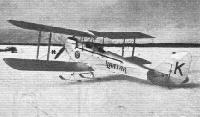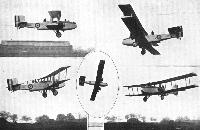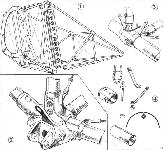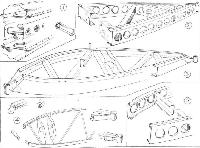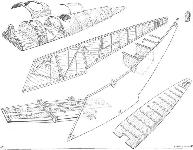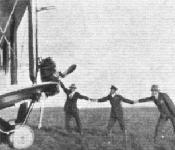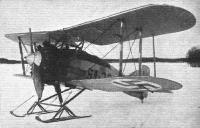Фотографии
-
Регистрационный номер: G-EBPF SURVEYING THE ZAMBESI RIVER: A pictorial record of the aerial survey of the Zambesi River carried out by the Aircraft Operating Co., Ltd. (1)-(2) Converting the D.H.9-Nimbus from landplane to seaplane. (3) Ready for launching. (4) Launching. (5) Afloat! (6) Off for the first test flight. (7) Final adjustments. (8) Now for business!
Самолёты на фотографии: De Havilland D.H.9 - Великобритания - 1917
-
AMSTERDAM-BATAVIA-AMSTERDAM: A four-minute shower was sufficient to result in bogging Lieut. Koppen's Fokker (3 Armstrong-Siddeley "Lynx" engines) at Allahabad during the outward trip.
Самолёты на фотографии: Fokker F.VII / C-2 / F.XIV - Нидерланды - 1924
-
AMSTERDAM-BATAVIA-AMSTERDAM: In trouble once more; at Bangkok, on the return flight, the "Postduif" was badly bogged, resulting in slight damage and two days' delay.
An incident of Lt. Koppen's pioneer mail flight in 1927, when his F.VIIb became bogged at Bangkok.Самолёты на фотографии: Fokker F.VII / C-2 / F.XIV - Нидерланды - 1924
-
FIRST SUCCESSFUL AEROPLANE AT SOUTH KENSINGTON: The earliest biplane designed, built and flown by the Wright Brothers, is now on view at the South Kensington Museum, lent by Mr. Orville Wright. The engine was also designed and built by the famous pioneer brothers.
Самолёты на фотографии: Wright Flyer - США - 1903
-
Регистрационный номер: CH-171 LADY HEATH'S TOUR IN SOUTH AFRICA: The picture on is of historical interest. It shows the arrival of the Swiss pilot, M. Mittelholzer, in his Dornier-Merkur "Switzerland" at East London, in 1926, during his great flight from Switzerland to South Africa. He is seen standing before the propeller. As a direct result of this visit, the East London Club was formed later on.
Самолёты на фотографии: Dornier Do.B Merkur - Германия - 1925
-
Регистрационный номер: G-EBTD [2] A "MOTH" WITH AUTOMATIC SLOTS: Capt. Geoffrey de Havilland demonstrating a mistake often made by beginners: "Landing 10 ft. above the ground." Note that the elevators are hard up. In a normal machine a crash on a wing tip would almost certainly have followed. In this case the "Moth" merely bounced, and then settled quite comfortably.
Самолёты на фотографии: De Havilland Moth / D.H.60 - Великобритания - 1925
-
The Johannesburg Flying Meeting: A close finish. Lady Heath winning the 12-mile handicap race in her Avro "Avian," with Lieut. Bentley a good second in his D.H. "Moth." Note the big crowd.
Самолёты на фотографии: Avro Avian / Type 594/616 - Великобритания - 1926De Havilland Moth / D.H.60 - Великобритания - 1925
-
LADY HEATH'S TOUR IN SOUTH AFRICA: The Club's D.H. "Moth," with a group of members and the staff, which includes the instructor, Mr. Kurtz, who gives his services voluntarily.
Самолёты на фотографии: De Havilland Moth / D.H.60 - Великобритания - 1925
-
Регистрационный номер: K-SILA, K-SALF, OH-ILA BRITISH MACHINES IN FINLAND: Finland's first "Moth," on skis.
Самолёты на фотографии: De Havilland Moth / D.H.60 - Великобритания - 1925
-
Регистрационный номер: G-EBTD [2] An unpremeditated, but very convincing demonstration: In doing a stalled landing from 200 ft., Capt. de Havilland proved the safety of the "Moth," fitted with automatic slots. The undercarriage was intact, but the impact was too much for the fuselage. It will be seen that both cockpits are practically undamaged, and even if a passenger had been carried it is unlikely that he would have been hurt.
Самолёты на фотографии: De Havilland Moth / D.H.60 - Великобритания - 1925
-
Регистрационный номер: G-EBTE A NEW LIGHT AEROPLANE: The Parnall "Imp" with Armstrong-Siddeley "Genet" engine is of somewhat unorthodox design. The top plane has a pronounced sweep-back, and the wings are cantilevers. The wing arrangement was evidently chosen so as to give a good view from both cockpits.
Самолёты на фотографии: Parnall Imp - Великобритания - 1927
-
Регистрационный номер: G-EBRQ THE AIR CAMPERS: This idyllic picture shows one of Mr. "Harold Brooklyn's" camping spots during one of his air tours in this country. He does not reveal the identity of the spot, and perhaps he is wise, for his choice is so excellent that it might quickly be followed. The two figures are seated in the collapsible rubber boat which was used during the night as a bed. The tent is 7 ft. by 5 ft., and other equipment taken to last two people a fortnight included bedding, stove and cooking utensils. All the gear was carried in the Westland "Widgeon" beside Mr. "Brooklyn" and his passenger.
Самолёты на фотографии: Westland Widgeon - Великобритания - 1924
-
THE BOULTON & PAUL "SIDESTRAND": Front and three-quarter front views. Large span, and "clean" fuselage and engine nacelles are characteristic features.
Самолёты на фотографии: Boulton Paul Sidestrand / P.29 - Великобритания - 1926
-
Регистрационный номер: J7938 [2] THE BOULTON & PAUL "SIDESTRAND": Three-quarter rear view. The careful streamlining of the engine nacelle can be seen in this photograph.
Самолёты на фотографии: Boulton Paul Sidestrand / P.29 - Великобритания - 1926
-
Регистрационный номер: J7938 [2] SPAN2/W: Five photographs of the Boulton & Paul "Sidestrand" in various attitudes, which show the large span and "clean" lines of the machine.
Самолёты на фотографии: Boulton Paul Sidestrand / P.29 - Великобритания - 1926
-
THE BOULTON & PAUL "SIDESTRAND I": 1, The engine mountings for the Bristol "Jupiter" are designed to avoid getting torque reaction loads as bending moments on the wing spars. A typical fuselage joint is illustrated in 3, and dissected in 4. Note particularly the locked-joint tube longeron and the magnesium alloy pad with flat faces for the fittings. A slightly different fuselage joint is shown in 2.
Самолёты на фотографии: Boulton Paul Sidestrand / P.29 - Великобритания - 1926
-
THE BOULTON & PAUL "SIDESTRAND I": Some constructional details of the wings. 1 is a spar section, with inset showing the distance-tube bracing the web walls together. A standard wing wib is shown in 4. The attachment to the spars is by means of the notched plates shown, the notches fitting over the spar flanges along the line of rivets. A somewhat stronger form of rib, used at points where concentrated loads occur, is illustrated in 2, while 3 shows a rudder rib. Further details are illustrated in 5.
Самолёты на фотографии: Boulton Paul Sidestrand / P.29 - Великобритания - 1926
-
One of the undercarriage "legs'' of the Boulton & Paul "Sidestrand." The streamline fairing has been removed to show the arrangement.
Самолёты на фотографии: Boulton Paul Sidestrand / P.29 - Великобритания - 1926
-
Diagrammatic representation of an undercarriage "leg" of the Boulton & Paul "Sidestrand I." The valve has a leak hole in its head, and ports in the tubular stem.
Самолёты на фотографии: Boulton Paul Sidestrand / P.29 - Великобритания - 1926
-
Boulton & Paul "Sidestrand" 2 Bristol "Jupiter VI" Engines
Самолёты на фотографии: Boulton Paul Sidestrand / P.29 - Великобритания - 1926
-
THE UBIQUITOUS "HORSLEY": These photographs show a Hawker "Horsley" fitted with one of the new Armstrong-Siddeley "Leopard" radial engines which resemble the famous "Jaguar" in many respects but are of much higher power. The "Horsley-Leopard" combination has provided valuable information and there would seem to be no end to the purposes for which the "Horsley" can be successfully used.
Самолёты на фотографии: Hawker Horsley / Dantorp - Великобритания - 1925
-
The Finnish Air Display: View of Santa Hamina, the Helsingfors seaplane station, which was the operating base for the Pageant. The machines in the background are G.L. single-seaters, and in the foreground some Hansa Brandenburgs.
Самолёты на фотографии: Gourdou-Leseurre GL-2 / GL-21 / GL-22 / GL-23 / GL-40 - Франция - 1919Hansa-Brandenburg W.29 / W.33 - Германия - 1918
-
Регистрационный номер: G-EBOV This is the great "little" Australian pilot, Mr. "Bert" Hinkler, who has stirred the world with his flight to Australia in 16 days as much as Lindbergh did with the lone Atlantic flight last year.
Самолёты на фотографии: Avro Avian / Type 594/616 - Великобритания - 1926
-
THE AVRO "AVIAN III": Three-quarter front view. Note the neat engine cowling and "clean" nose.
Самолёты на фотографии: Avro Avian / Type 594/616 - Великобритания - 1926
-
THE AVRO "AVIAN III": Photographic plan view of the control unit. Note the pedal adjustment for pilots of different heights.
Самолёты на фотографии: Avro Avian / Type 594/616 - Великобритания - 1926
-
THE AVRO "AVIAN III": Above - A top centre-section with and without the petrol tank. Below - A wing root of the lower plane. This is of triangular plan form to suit the folding arrangements of the wings.
Самолёты на фотографии: Avro Avian / Type 594/616 - Великобритания - 1926
-
Регистрационный номер: G-EBWK [3] THE AVRO "AVIAN III": Three views of the machine in flight, as a landplane, and a view of it fitted with floats.
Самолёты на фотографии: Avro Avian / Type 594/616 - Великобритания - 1926
-
The Johannesburg Flying Meeting: An interested group round Lady Heath's "Avian." From left to right: Mr. A. N. Other; Capt. Bellin, Instructor to the Jo'burg Club, Major Miller (in white cap); Glen Bateman, the first soloist of any S. African flying Club; Rod Douglas, Secretary of Jo'burg Club; and behind Lady Heath (in cockpit), Lieut. Bentley.
Самолёты на фотографии: Avro Avian / Type 594/616 - Великобритания - 1926
-
Регистрационный номер: G-EBWK [3] THE AVRO "AVIAN III": Three-quarter rear view.
Самолёты на фотографии: Avro Avian / Type 594/616 - Великобритания - 1926
-
Регистрационный номер: G-EBWK [3] THE AVRO "AVIAN III": This view shows the machine with the port wings spread and the starboard wings folded, to illustrate how undercarriage wheels move back when wings are folded. The telescopic jury struts fold flat aganst the top plane when in flight.
Самолёты на фотографии: Avro Avian / Type 594/616 - Великобритания - 1926
-
LADY HEATH'S TOUR IN SOUTH AFRICA: The arrival of Lady Heath at East London in her Avro "Avian"
Самолёты на фотографии: Avro Avian / Type 594/616 - Великобритания - 1926
-
THE AVRO "AVIAN III": This side elevation shows most of the details in the fuselage. The manner in which the undercarriage wheels move back and up when the wings are folded is indicated by dotted lines.
Самолёты на фотографии: Avro Avian / Type 594/616 - Великобритания - 1926
-
On the left, a sketch of the very simple tubular engine mounting, and on the right, details of the axle fairing.
Самолёты на фотографии: Avro Avian / Type 594/616 - Великобритания - 1926
-
THE AVRO "AVIAN III": Details of the Fuselage Construction. The simplicity of the "box" type of fuselage is well brought out. Note the supports for the control units. The fittings on the cross beams project through the sides of the fuselage. The luggage compartment has a hinged hatch. The sketches actually show how the main components of the fuselage are built for mass production.
Самолёты на фотографии: Avro Avian / Type 594/616 - Великобритания - 1926
-
Avro "Avian" Mk.III 80 h.p. "Cirrus" Engine
Самолёты на фотографии: Avro Avian / Type 594/616 - Великобритания - 1926
-
THE BREDA A.7 MONOPLANE: Three-quarter front view of the recent Italian reconnaissance machine fitted with a 500 h.p. Asso engine.
Самолёты на фотографии: Breda A.7 - Италия - 1926
-
THE BREDA A.7 MONOPLANE: The machine can be converted into a seaplane by replacing the wheel undercarriage with twin float gear.
Самолёты на фотографии: Breda A.7 - Италия - 1926
-
Breda A-7 Monoplane 500 hp I.F. Asso Engine
Самолёты на фотографии: Breda A.7 - Италия - 1926
-
THE "GLOSTER IV B": Front view. Note the excellent angles made by the bracing wires.
Самолёты на фотографии: Gloster IV - Великобритания - 1926
-
Регистрационный номер: N223 THE "GLOSTER IV B": View of the nearly symmetrical tail surfaces.
Самолёты на фотографии: Gloster IV - Великобритания - 1926
-
THE "GLOSTER IV B": Reducing interference was one of the great problems in the design. These photographs indicate how interference between wing roots and fuselage was reduced by avoiding sharp angles. The top plane fairs into the outer cylinder blocks, and the lower wing roots curve down and outwards, being initially at right angles to the surface of the body.
Самолёты на фотографии: Gloster IV - Великобритания - 1926
-
THE "GLOSTER IV B": Some constructional details. Above, a general view of the engine mounting; and below, some of its details.
Самолёты на фотографии: Gloster IV - Великобритания - 1926
-
THE "GLOSTER IV B": The wing surface radiators. On the left, the outer end of the lower plane radiator, showing also the Duralumin interplane strut. On the right, the water piping entering the fuselage at trailing edge of lower plane.
Самолёты на фотографии: Gloster IV - Великобритания - 1926
-
THE "GLOSTER IV B": 1, shows how anti-lift wires are prevented by rubber buffers from going slack when relieved of load. 2, the "double-diagonal" method of planking the fuselage. 3, showing how rivets are finished off flush with skin of float to reduce air friction.
Самолёты на фотографии: Gloster IV - Великобритания - 1926
-
THE "GLOSTER IV B": On the left, the arrangement of the seven petrol tanks in the fuselage. There are three main tanks, three auxiliary tanks, and one service tank. On the right, a diagrammatic perspective representation of the water system, one-half only being shown. Note the radiator on the port float.
Самолёты на фотографии: Gloster IV - Великобритания - 1926
-
Gloster IV B Napier "Lion" Racing Engine
Самолёты на фотографии: Gloster IV - Великобритания - 1926
-
AERIAL FIRE FIGHTING IN CANADA: Our picture, which we reproduce through the courtesy of the office of the High Commissioner for Canada, shows a forest fire near Lake Winnipeg, Manitoba, with one of the suppression aircraft (a Vickers flying-boat) of the R.C.A.F. standing by.
Самолёты на фотографии: Canadian Vickers Vedette - Канада - 1924
-
THE GREAT R.A.F. FLYING BOAT CRUISE: Our picture shows the officers and men of one the four Supermarine-Napier "Southampton" metal flying boats which have now reached Singapore. The "Flagship." Group Capt. H. M. Cave-Browne-Cave (right, centre) and Flight-Lieut. H. G. Sawyer.
Самолёты на фотографии: Supermarine Southampton / Solent - Великобритания - 1925
-
INCIDENTAL: Starting up the Bristol "Jupiter" of a Service D.H.9.
Самолёты на фотографии: De Havilland D.H.9J - Великобритания - 1926
-
A NEW AVRO COMMERCIAL AEROPLANE: To be known as the type 610, this machine will have seating accommodation for four passengers. The engine will be a radial of the 200 h.p. class. The monoplane strongly resembles the type which has become so popular in America during the last few years.
Самолёты на фотографии: Avro Type 610 - Великобритания - 1928
-
"Jupiters" in France: The C.A.M.S.51 flying-boat, fitted with two "Jupiter" engines, which, piloted recently by Lieut. Paris at St. Raphael, created a world's record for seaplanes, attaining an altitude of 4,684 m. (15,370 ft.) with a load of 2,000 kgs. (4,410 lb.).
Самолёты на фотографии: CAMS CAMS 51 / CAMS 53 / CAMS 56 - Франция - 1926
-
Demonstrating a "slotted Moth": General view of the machine.
Самолёты на фотографии: De Havilland Gipsy Moth / Moth X - Великобритания - 1928
-
The new type of undercarriage used for experimental work on slotted "Moths."
Самолёты на фотографии: De Havilland Gipsy Moth / Moth X - Великобритания - 1928
-
Регистрационный номер: GA-38 BRITISH MACHINES IN FINLAND: Finland's Gloster "Gamecock II," on skis.
Самолёты на фотографии: Gloster Gamecock - Великобритания - 1925
Статьи
- Flight








